An ancient harbour dating back to 800 BC, a mosque that was home to rare manuscripts and one of the world’s oldest Christian monasteries are just a few of at least 195 heritage sites that have been destroyed or damaged since Israel’s war on Gaza began on October 7, according to an NGO documenting war damage on cultural sites.
Wiping out the cultural heritage of a people is one of the many war crimes South Africa alleges against Israel in a lawsuit that was heard this past week at the International Court of Justice. It states: “Israel has damaged and destroyed numerous centres of Palestinian learning and culture”, including libraries, religious sites and places of ancient historical importance.
Gaza, one of the world’s longest inhabited areas, has been home to a pastiche of people since at least the 15th century BC, according to historians.
Empires – including the ancient Egyptians, Assyrians and Romans – have come and gone, at times dominating the land of the Canaanites, the ancestors of the Palestinians, leaving relics of their own cultural heritage behind. Greeks, Jews, Persians and Nabateans have also lived along this stretch of coast over the centuries.
Strategically located on the Mediterranean’s eastern shores, Gaza was always in a prime position on the trade routes from Eurasia to Africa. Its ports made it a regional hub for commerce and culture. Since at least 1300 BC, the Via Maris – a route running from Heliopolis in ancient Egypt, cutting across Gaza’s western coastline and then crossing into Syrian lands – was the main route that travellers would take on their journeys to Damascus.
“The crime of targeting and destroying archaeological sites should spur the world and UNESCO into action to preserve this great civilisational and cultural heritage,” Gaza’s Ministry of Tourism and Antiquities said after Gaza’s Great Omari Mosque was destroyed in an Israeli air strike on December 8.
As a result of that particular strike, an ancient collection of manuscripts kept at the mosque may be forever lost. “The manuscript collections remained in the vicinity of the mosque and are currently inaccessible because of the continuing conflict,” Columba Stewart, the CEO of the Hill Museum and Manuscript Library (HMML), told Al Jazeera soon after the strike.
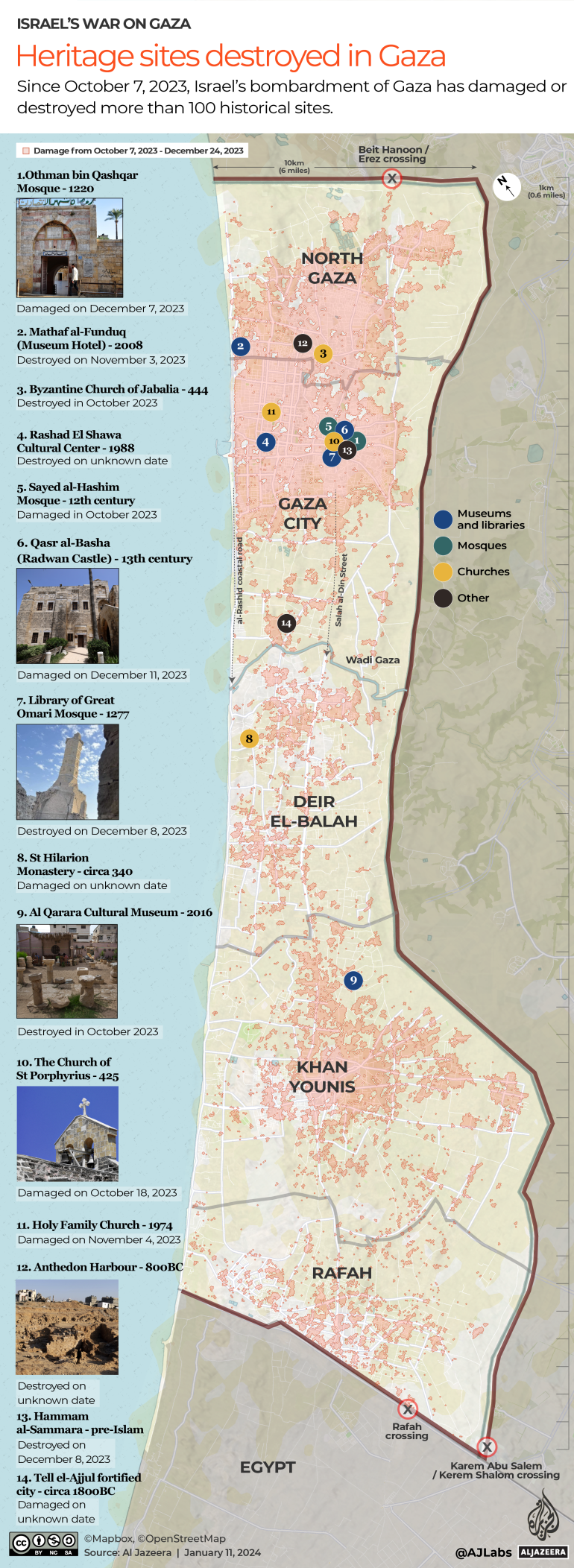
The 1954 Hague Convention, agreed to by both Palestinians and Israelis, is supposed to safeguard landmarks from the ravages of war. Isber Sabrine, president of an international NGO that documents cultural heritage, explained that crimes affecting cultural heritage are part of the “collateral damage of genocide”.
“Libraries serve as cultural repositories, and attacking them is an attack on cultural heritage. What is happening now is a war crime. It goes against the first Hague convention,” Sabrine said. “Israel is trying to erase the connection of the people with their land. It’s very clear and intentional. Gaza’s heritage is part of its people, it’s history and their connection.”
While cultural genocide erases tangible heritage like museums, churches and mosques, intangible heritage includes customs, culture and artefacts. These, too, have been damaged, including the Union of Palestinian artists on Jalaa Street in Gaza City and the well-known clay pots once baked in the city’s al-Fawakhir district.
In a statement to Al Jazeera, UNESCO said: “While priority is rightly given to the humanitarian situation, the protection of cultural heritage in all its forms must also be taken into account. In accordance with its mandate, UNESCO calls on all actors involved to strictly respect international law. Cultural property should not be targeted or used for military purposes, as it is considered to be civilian infrastructure.”
Here’s a closer look at some of the sites that have been destroyed or damaged:
Museums
There are four museums in Gaza, and two have been levelled, the International Council of Museums-Arab (ICOM-Arab) confirmed to Al Jazeera.
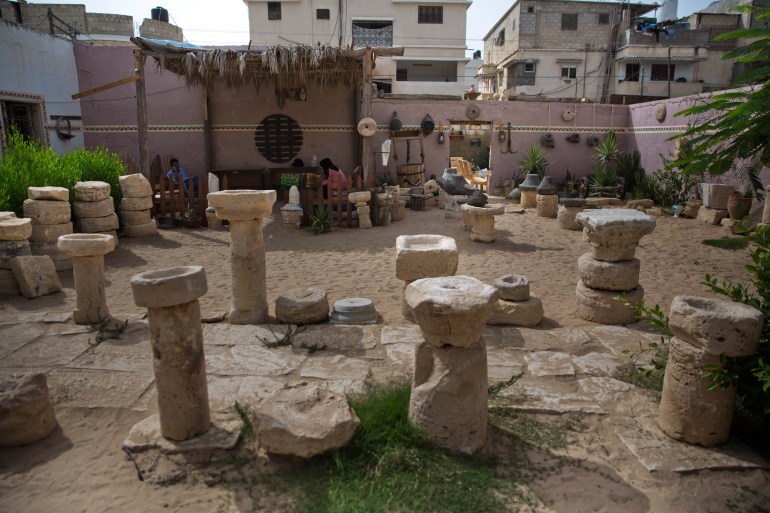
The Rafah Museum had completed a 30-year project to curate a collection of ancient coins, copper plates and jewellery, making it Gaza’s main museum of Palestinian heritage. It was an early victim in the war, destroyed in an air strike on October 11.
Farther east and once sitting on a hilltop, Al Qarara Museum (also known as the Khan Younis Museum) was opened in 2016 by Mohamed and Najla Abu Lahia, a husband and wife team who said they wished to preserve a history of Gaza’s lands and heritage for generations to come.
Its collection consisted of about 3,000 artefacts dating back to the Canaanites, the Bronze Age civilisation that lived in Gaza and across much of the Levant in the second century BC.
All that remains of the museum now are shards of pottery and smashed glass that has been blown out of the widows during an October air strike.

ICOM-Arab told Al Jazeera this museum was given advanced warning by Israeli forces to empty its contents and evacuate to the south of Gaza.
The Mathaf al-Funduq, a small museum opened in 2008 and housed in the Mathaf Hotel in northern Gaza, was damaged by shelling on November 3.

In Gaza City, the 13th-century Qasr Al-Basha, or Pasha’s Palace, was turned into a museum in 2010 by the Palestinian Ministry of Tourism, and a collection of artefacts from different periods of Gaza’s history was on display. The site was hit by Israeli air strikes on December 11, damaging its walls, courtyard and gardens.
Like many of the heritage sites in Gaza, this building has changed ownership and functions several times over its history. The two-storey fort, built by Mamluk ruler Sultan Zahir Baybars in the mid-13th century, was once a seat of power, constructed as a defence against the Crusaders and Mongol armies. During the 17th century, it was used by Ottoman rulers and once served as lodgings for the French commander Napoleon Bonaparte in 1799 when he entered Gaza to try to stave off an expected Ottoman invasion of Egypt, where the French held court.
Before the 1948 Nakba, when hundreds of thousands of Palestinians became refugees during the creation of Israel and many fled into Gaza, the palace served as a police station for the British, who controlled the area, and later, it became a Palestinian girls school.
Libraries
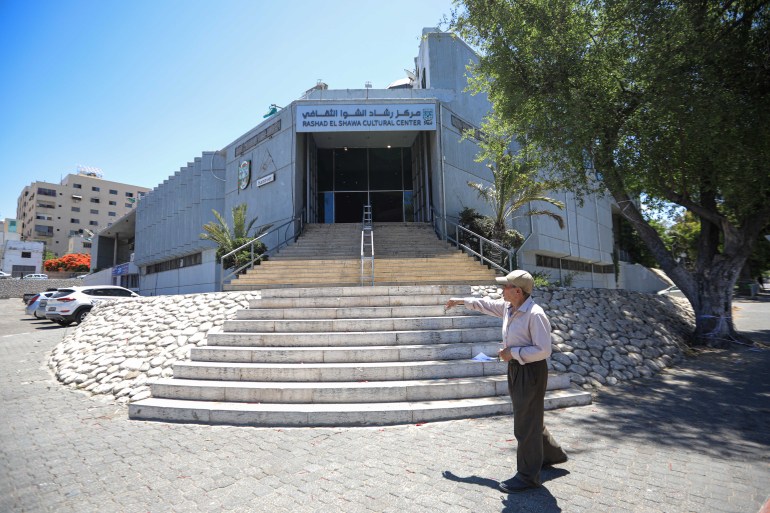
During a week-long pause in the Israeli bombardment that began on November 24, Palestinians were able to briefly survey the extent of the damage to their homeland. It rapidly became clear that many public service buildings had been destroyed, including the Rashad El Shawa Cultural Center in Gaza City, once the venue for peace talks between PLO leader Yasser Arafat and US President Bill Clinton in the 1990s. Samir Mansour’s community bookshop, which was painstakingly restored after the Israeli bombardment of 2021, was also badly damaged.
The Library of the Great Omari Mosque in Gaza City was once filled with rare manuscripts, including old copies of the Quran, biographies of Prophet Muhammad and ancient books on philosophy, medicine and Sufi mysticism. The library, established by Sultan Zahir Baybars and opened in 1277, once boasted a collection of 20,000 books and manuscripts.
![A digitised copy of an 18th Century legal treaty curated at the Al Omari Mosque library [Courtesy of Hill Museum and Manuscript Library]](https://www.aljazeera.com/wp-content/uploads/2023/12/Gaza-manuscript-2-1703509310.jpg?w=770&resize=770%2C434)
Many of the rare books and manuscripts housed there were lost or destroyed during the Crusades and World War I, leaving only 62 books. These hard copies have now also been destroyed in a strike on the Omari Mosque on December 8.
A digitisation project of these books was completed last year by the Hill Museum and Manuscript Library and at the British Library and are accessible online at HMML Reading Room.
Mosques
Gaza’s Tourism and Antiquities Ministry estimated that as many as 104 mosques have been damaged or destroyed since the start of the Israeli assault. This includes the Othman bin Qashqar Mosque in Gaza City’s Zeitoun neighbourhood, which was built in 1220 at the site where Prophet Muhammad’s great-grandfather is believed to have been buried. It was badly damaged in an air strike on December 7.
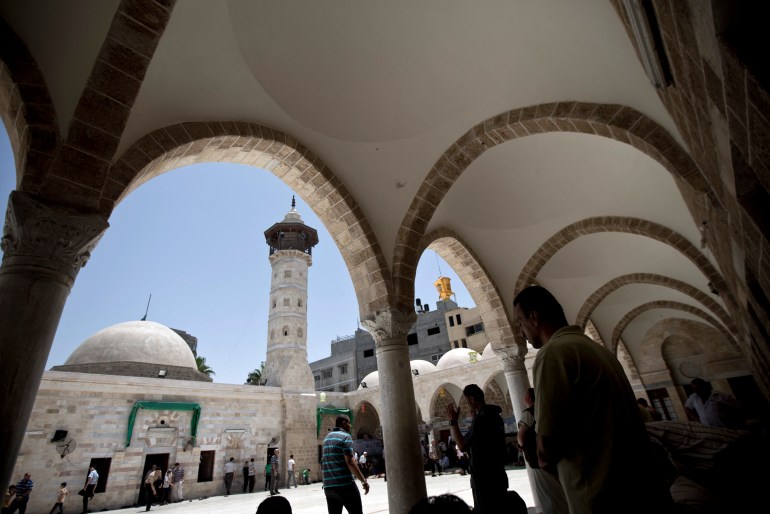
The Sayed al-Hashim Mosque, built sometime in the 12th century and rebuilt in 1850, was damaged in an October air strike. This mosque, built of sturdy limestone in the Old City of Gaza, is of great significance for Muslims because it’s said to house the tomb of another of Prophet Muhammed’s great-grandfathers, Hashim bin Abd Manaf. Local lore says he was a merchant travelling back to Mecca from Syria when he became ill, died and was buried in what is now Gaza’s Daraj neighbourhood.
![There are no clear dates for when Al Sayed Hashim Mosque was first built, but archaeologists suggest it was built in the 12th century [Abdelhakim Abu Riash/AJE]](https://www.aljazeera.com/wp-content/uploads/2023/12/Al-Sayed-Hashim-Mosque-1703596437-rotated.jpeg?w=770&resize=770%2C942)
A brief interlude of Crusader dominance followed the mosque’s contruction before the Mamluks took over and rebuilt it. It would later be renovated under the watch of Ottoman Sultan Abdul Majid in 1850 and again after damage in 1917 during World War I.
Early in the current war, the mosque caught fire during an Israeli air strike, which damaged its walls and ceilings.
The Great Omari Mosque has been a site of religious worship in one form or another for about two millennia.
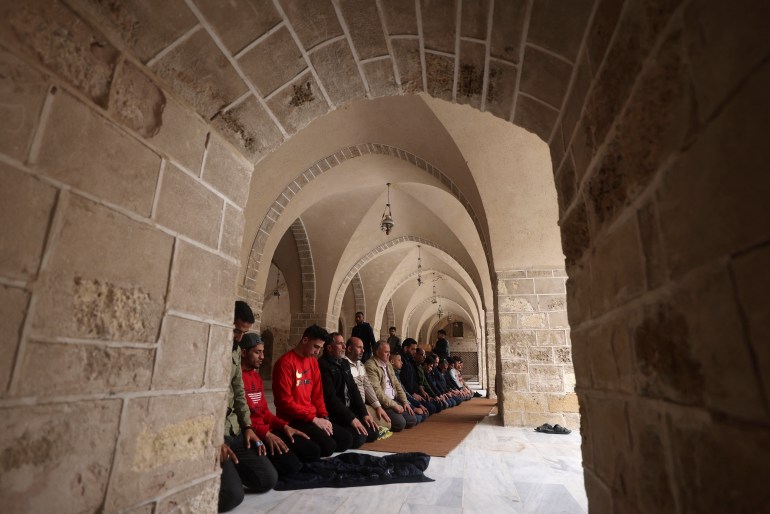
Known in Arabic as Al-Masjid al-Omari al-Kabir, it’s thought to be the first mosque built in the Gaza Strip 1,400 years ago. On December 8, it was destroyed in an Israeli air strike.
Built out of local sandstone to accommodate as many as 5,000 worshippers for congregational prayers, all that remains is its Mamluk-era minaret, bent and broken.
“This was more than just a mosque for the community,” Sabrine said. “One man told me he felt more sad about the destruction of the mosque than that of his own home.”

Named after the second caliph of Islam, Omar bin Khattab, it was built in the seventh century on top of the ruins of an ancient church built in 406, which itself was built over the foundations of a pagan temple to the Canaanite fertility god, Dagon.
Like many historical sites that outlive the people who built them, this one has different stories behind it. According to one account, Samson, an Israelite warrior mentioned in the Old Testament who was known to hold his strength in his hair, became buried under the rubble of the structure after he brought the walls of the pagan temple down upon himself. Others say the temple fell after the Byzantines burned down all pagan sites when they took over rule of Gaza from 390.
Ayyubid conqueror Salah al-Din turned the building back into a mosque after the Crusaders had converted it to St John the Baptist Cathedral.
The mosque had been used as a place of worship by the local Muslim community since 1291 and had served as a focal point for gatherings and cultural activities.
In partnership with the British Library Endangered Archives Programme, HMML last year digitised a selection of ancient, single copy books from the mosque’s library that are unavailable “anywhere else in the world”, an HMML adviser told Al Jazeera. Works included the 14th century Book of Sufi Poems of Ibn-Zokaa and books by famed Gazan jurists, including Sheikh Skaike.
The December strike was not the first time the mosque had been hit. It was also struck on October 19 and was also damaged during World War I and again during the 2014 assault by Israel on Gaza.

Churches
The floor of the Byzantine Church of Jabalia, built in 444, was once decorated with colourful mosaics depicting animals, hunting scenes and palm trees. Its walls were adorned with 16 religious texts written in ancient Greek, which dated back to the era of Emperor Theodosius II, who ruled Byzantium from 408 to 450.
The Palestinian Tourism and Antiquities Ministry reopened the church in early 2022 after a three-year restoration in collaboration with a French organisation, Premiere Urgence Internationale, and the British Council.
At the time, the ministry’s Nariman Khella said: “The church was discovered during the paving of Salah al-Din Street, and the first thing that was discovered were two tombs, one for an old person and the other for a young child.” That same year, a farmer discovered a series of intricate mosaics nearby. The state of the tombs and the nearby mosaics remains unclear.
As for the historic church itself, it was destroyed in October by Israeli air strikes.
The Monastery of Saint Hilarion is in an area called Tell Umm Amer in Nuseirat village on the coast and dates back to about 340 during Roman rule of the region. A “tell”, is a flat-topped mound, or hill, often marking the position of an ancient city.
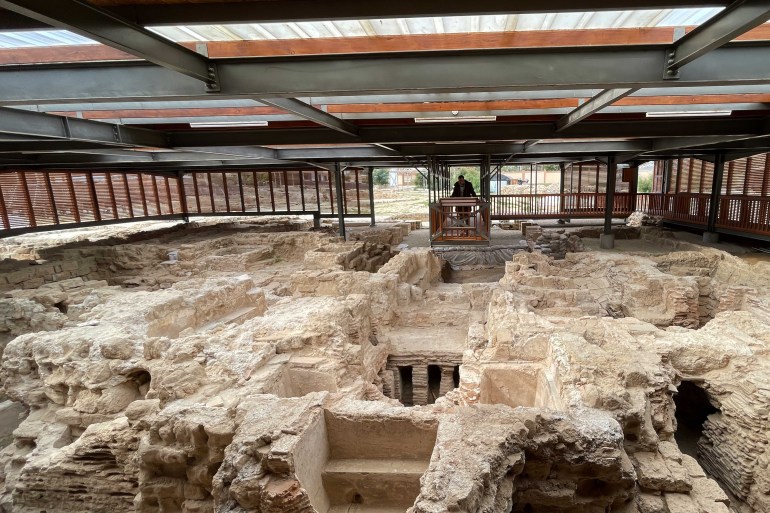
To withdraw from worldly life and immerse himself in spiritual pursuits, Saint Hilarion, a Christian who is said to be the founder of monasticism, built a small and simple room for himself in what he thought was a secluded spot in today’s Deir el-Balah in the central Gaza Strip. Despite his desire for solitude, pilgrims sought him out in search of cures for ailments and spiritual guidance. Buildings around his simple room spread over the years, eventually becoming one of the largest monasteries in the Middle East.
Within the 25-acre (10-hectare) monastery’s sanctuary, there would eventually be five churches, a burial site, a baptism hall and ancient baths. Mosaics and limestone decorated the floors and walls to welcome pilgrims travelling the Via Maris from Egypt to Damascus.
Damaged in an earthquake in 614, the site lay abandoned until Palestinian archaeologists started excavations in the late 1990s. The site, which UNESCO added to its Tentative World Heritage list in 2012, has been damaged in the Israeli bombardments.
The Greek Orthodox Church of Saint Porphyrius has been located in Zeitoun for 16 centuries. It was struck and damaged on October 19.

Considered to be the third oldest church in the world, Saint Porphyrius was built in 425 on the foundations of an ancient pagan site and was named after the Byzantine saint who had made it his mission to close down the pagan temples. He is thought to have been buried on the grounds of the church.
Like other significant sites, this church was turned into a mosque in the seventh century but reverted back to a church in the 1150s when Crusaders reclaimed it. Renovated in 1856, it has remained a place of worship for Gaza’s Christian community to pray and seek shelter during times of conflict.
In the October 19 Israeli bombing, 17 people were killed when the roof of the church caved in. The Greek Orthodox Patriarchate of Jerusalem said targeting the church “constitutes a war crime”. The neighbouring Ottoman-style Katib al-Wilaya Mosque, built in the 15th century, sustained damage in the same attack.
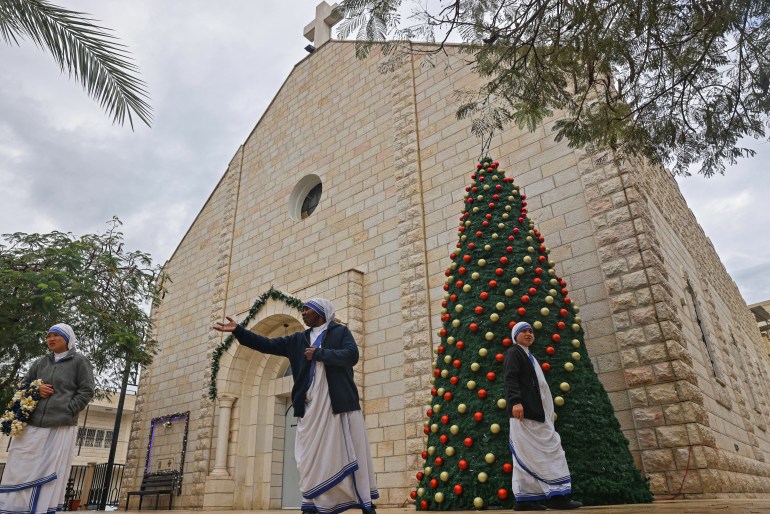
The Holy Family Church, built in 1974, is Gaza’s only Roman Catholic church and a shelter for the local community. It was hit in an air strike on November 4. A school in the church complex was partially destroyed.
The Latin Patriarchate of Jerusalem confirmed that shrapnel from Israeli military strikes on buildings near the Holy Family Church had destroyed water tanks and solar panels on the roof of the church.
Other heritage sites
Ard-al-Moharbeen, or the Roman Necropolis, was unearthed last year by archaeologists from Palestine and France after construction workers building new homes discovered tombs at the site.
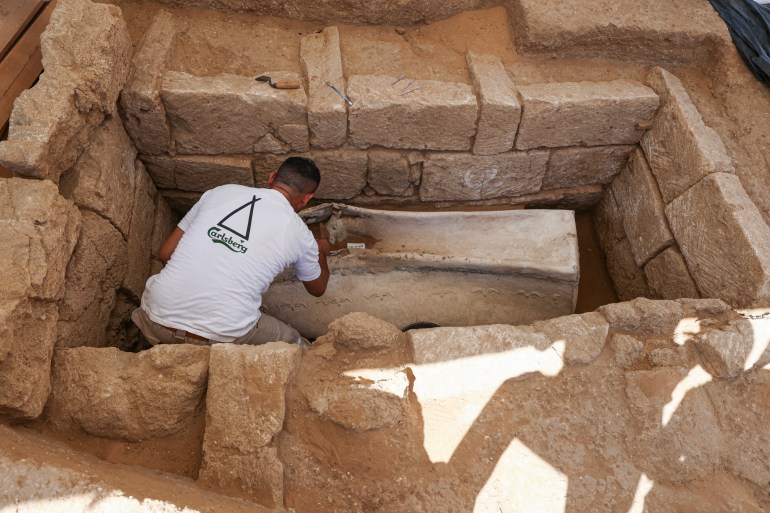
At least 134 tombs dating from 200 BC to 200 AD with skeletons still intact were found in what is believed to be a Roman necropolis.
Two intricately decorated lead sarcophagi were discovered, one with grape harvest motifs and the other featuring dolphins.
Fadel Alatel, an archaeologist in Gaza and part of the Heritage for Peace network, was working on this excavation before October 7. He told Al Jazeera he was fearful of what may have happened to these rare tombs.
“This is in the area where white phosphorous was dropped. Its damage to the site is unknown,” he said. “Also the winter weather and heavier rains may mean the rare discovery could be destroyed.”
Alatel has worked to preserve Gaza’s heritage and archaeology through countless Israeli air strikes but said this time the situation is much worse and he has been unable to return to the site to survey the extent of the damage.
Forensic Architecture (FA), an investigative journalism agency based at Goldsmiths, University of London, has been documenting the destruction of cultural heritage in Gaza in its investigation Living Archaeology. On October 8, one day after the Hamas attacks on Israel that started the war, researchers at the agency using satellite technology found evidence of three large craters from Israeli rockets at the archaeological site.
In a report, FA stated: “This disregard for and destruction of Palestinian cultural heritage both diminishes Palestinian claims to statehood and denies Palestinians their fundamental right to access and preserve their own heritage.”
The fate of another ancient site, a harbour, is known. It has been destroyed.
Located in the northwest corner of Gaza, the enclave’s first known seaport, Anthedon, also known as Balakhiyah or Tida, was inhabited from 800 BC to 1100 AD, or from the Mycenaean era to the early Byzantine age. It became an independent city during the Hellenistic period.
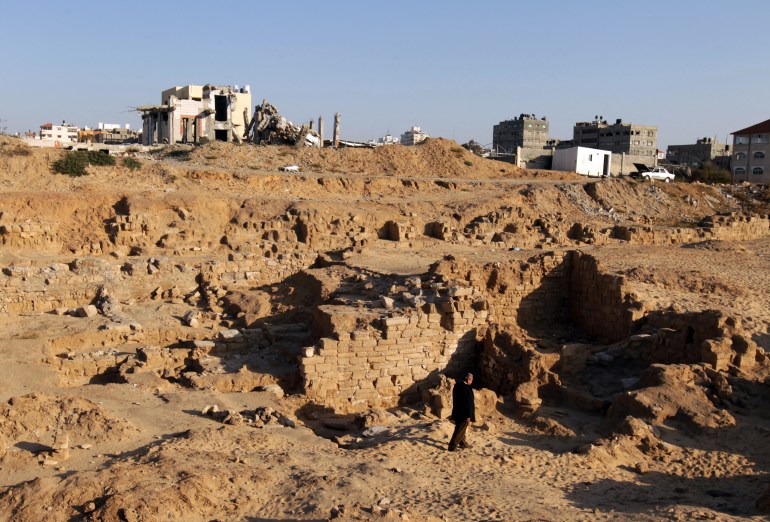
After Roman temple ruins and mosaic floors were discovered on the 5-acre (2-hectare) archaeological site, it was placed by UNESCO on its Tentative World Heritage list in 2012.
Other remains date back to the late Iron Age and the Persian, Hellenistic, Roman and Byzantine periods.
The Hammam al-Sammara, or Samaritan Bathhouse, was destroyed on December 8. It had pre-dated Islam and was likely established by the Samaritans, a religious sect of ethnic Jews who lived in the Zeitoun area, also known as the Jewish Quarter. The area had a thriving Jewish community until Crusader rule in the 12th century. The last Palestinian Jewish family lived in the neighbourhood until the 1960s.
The only other piece of Jewish history in Gaza was the King David Mosaic, which dates to 508. It was discovered at the remains of a sixth century synagogue and depicted King David playing a harp. It was transferred to the Israel Museum in Jerusalem after Israel captured the Gaza Strip during the 1967 Six-Day War.
At one time, Gaza City had 38 bathhouses. Many were lost during wars and occupation because there were a lack of resources to maintain them.
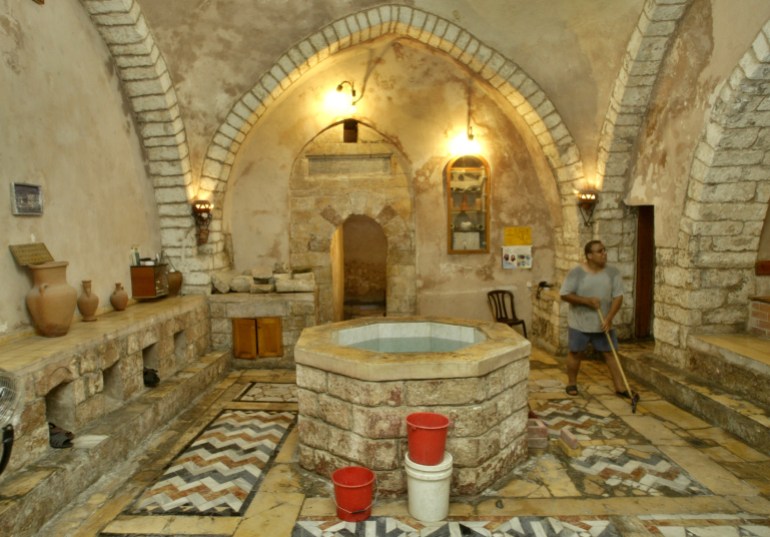
The Hammam al-Sammara was the last one remaining. A sign once hung by its entrance stating it had been restored in 1320 by Mamluk ruler Sangar ibn Abdullah.
The site was a popular meeting place for Gazans to socialise and seek cures for ailments under its traditional vaulted ceilings. With intricate, inlaid marble tiled floors the hammam was still heated using traditional wood-fired ovens and aqueducts.
Located northeast of Nuseirat, the fortified city of Tell el-Ajjul, or Calves Hill, sits between the Mediterranean Sea and Wadi Gaza. It was established about 2000 to 1800 BC and has been damaged in the Israeli bombardment.
British Egyptologist William Matthew Flinders Petrie discovered the site in the 1930s after he moved east into Palestine after excavating Giza’s Great Pyramid. Here he discovered gold jewellery and ancient coins used by the Hyksos, Romans and Byzantines.
Most of his discoveries made between 1930 and 1934 when Gaza was under the British Mandate now reside at the British Museum’s Institute of Archaeology in London. Other finds included imported pottery from Cyprus, bottles and scarabs, with many pieces dating as far back as the Bronze Age about 3,600 years ago. The artefacts also suggest Tell el-Ajjul was once a trading hub.
Status unknown
The status of Gaza’s many other historic sites remains unknown. According to Alatel, it is difficult to keep up with the situation on the ground because it “changes every five minutes”. Local photographers have been unable to return to many sites to assess the damage because of the dangerous situation.
These are a few of the sites whose condition is not yet known:
Dating back to the 14th century, the Khan Younis caravanserai was built to serve the needs of people travelling along the Via Maris.
Named after its Mamluk founder, Younis al-Nuruzi, the khanate, or khan, was a type of inn that was popular in the region from around the 10th century, offering a place for travellers to rest and take a break during their journeys. This caravanserai, built in 1387, has a mosque, a post office and storage rooms.
During an archaeological excavation from 1972 to 1982, a collection of unique, human-shaped pottery coffins were discovered at Deir el-Balah Cemetery, dating back to the late Bronze Age (1550-1200 BC).
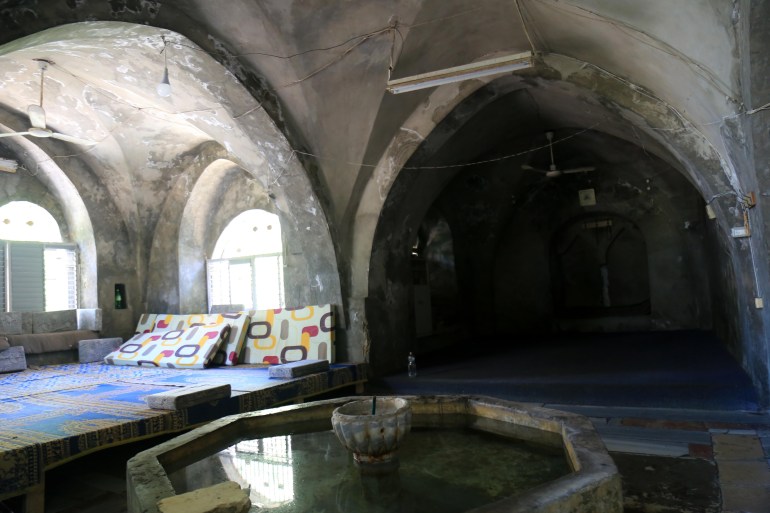
Located in the Daraj neighbourhood, the Sufi mosque of Ahmadiyyah Zawiya was established in 1336 by followers of Sheikh Ahmad al-Badawi, a well-known 12th century Sufi scholar who lived in Gaza.
Sufi worshippers would gather there for collective prayers on Mondays and Thursdays. There has been shelling in the area, Alatel said, but it is as yet unknown what has become of the sacred site.
“All our heritage sites are clearly marked, yet the Israeli military strikes, the tanks and the bulldozers continue,” the archaeologist said. “But I have faith all this will end. Even if they attempt to destroy our past, we will build back Gaza’s future.”
Sumber: www.aljazeera.com
 Skip to content
Skip to content

